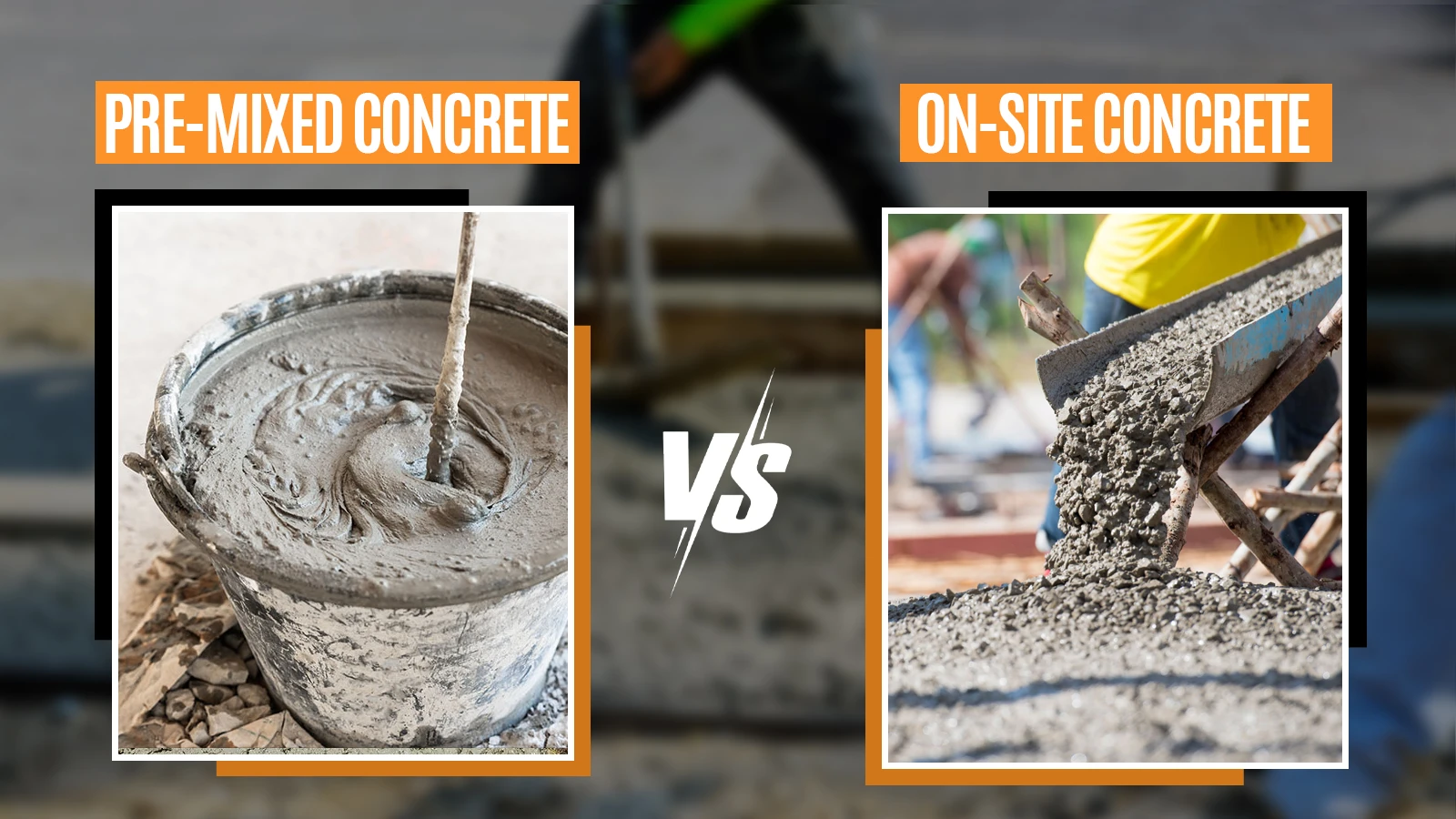Construction projects require concrete, but choosing between on-site mixing and pre-mixed delivery affects quality, cost, timeline, and project success. Each method offers distinct advantages depending on project size, location, and specific requirements.
Understanding the differences between these concrete options helps contractors, builders, and project managers make informed decisions that optimize results while controlling costs and timelines.
If you need expert guidance on concrete options for your project, get professional consultation today with Pro-Mix Concrete.
[Get Concrete Consultation: 020 7458 4747]
What Is Pre-Mixed (Ready-Mix) Concrete?
Pre-mixed concrete is manufactured at specialised batching plants under controlled conditions and delivered to construction sites in mixer trucks, ready for immediate placement.
Professional batching plants combine cement, aggregates, water, and additives using precise measurements and standardised procedures. This controlled environment ensures consistent quality and uniform concrete properties across multiple deliveries.
Pre-mixed concrete features:
- Manufactured at central batching facilities
- Strict quality control and testing procedures
- Consistent mix proportions and strength characteristics
- Delivered in specialised mixer trucks
- Ready for immediate placement upon arrival
Typical applications for pre-mixed concrete:
- Commercial building foundations and slabs
- Infrastructure projects like bridges and highways
- Large residential developments
- High-rise construction requires consistent quality
- Projects with tight timeline requirements
What Is On-Site Concrete Mixing?
On-site concrete mix involves combining cement, aggregates, water, and additives directly at the construction site using portable mixers or stationary mixing equipment.
Site mixing provides flexibility to adjust mix proportions based on immediate project needs, weather conditions, or specific placement requirements. This method works well for remote locations or projects requiring custom concrete formulations.
On-site mixing characteristics:
- Raw materials are stored and mixed at the construction site
- Portable or stationary mixing equipment is required
- Real-time mix adjustments are possible
- Immediate quality control by site personnel
- Custom batching for specific project requirements
Common on-site mixing applications:
- Remote construction sites without delivery access
- Small residential projects like driveways and patios
- Renovation projects with limited access
- Emergency repairs requiring immediate concrete
- Projects needing frequent mix adjustments
Professional equipment and expertise ensure optimal results.
[Explore Mixing Solutions: 020 7458 4747]
Key Differences Between Pre-Mixed and On-Site Concrete
Several critical factors distinguish pre-mixed concrete from on site concrete mix approaches, affecting project outcomes and costs.
Quality and Consistency
Pre-mixed concrete offers superior consistency due to controlled batching plant conditions, while on-site mixing quality depends on operator skill and site conditions.
Batching plants maintain strict quality control protocols with computerised batching, regular testing, and standardised procedures. On-site concrete mix quality varies based on operator experience, equipment condition, and environmental factors. Studies indicate that more than 50 % of material savings can be achieved by using efficient structural solutions when proper concrete placement techniques are employed.
Cost Considerations
Pre-mixed concrete typically has higher upfront costs but may provide overall savings through reduced labour, equipment, and waste management expenses.
On-site concrete mix appears cheaper initially but requires equipment rental, raw material storage, skilled operators, and cleanup procedures that can increase total project costs.
Cost comparison factors:
- Pre-mixed: Higher per-yard cost, lower labour requirements
- On-site: Lower material cost, higher labour and equipment needs
Convenience and Logistics
Pre-mixed concrete requires coordinated delivery scheduling and adequate site access, while on-site mixing needs raw material storage and mixing equipment space.
Ready-mix delivery depends on truck access, timing coordination, and immediate placement capabilities. On-site concrete mix requires space for material storage, mixing equipment, and cleanup operations.
Flexibility and Customisation
On-site concrete mix allows real-time adjustments to concrete proportions, while pre-mixed concrete offers limited modification options after batching.
Site mixing enables immediate responses to changing conditions, weather variations, or specific placement requirements. Pre-mixed concrete follows predetermined specifications with minimal adjustment possibilities.
Environmental Impact
Pre-mixed concrete centralises production and waste management, while on-site mixing can create material waste and environmental concerns if not properly managed.
Batching plants optimize material usage and implement comprehensive waste management systems. On-site concrete mix requires careful material handling to prevent waste and environmental contamination.
Advantages of Pre-Mixed Concrete
Pre-mixed concrete offers significant advantages in quality control, efficiency, and project management that benefit most construction applications.
Strict Quality Control and Uniformity
Computerised batching systems, regular testing protocols, and controlled environments produce consistent concrete that meets exact specifications every time.
Professional plants maintain certified testing laboratories and follow industry standards that guarantee uniform strength, workability, and durability characteristics across all deliveries.
Time Efficiency and Faster Project Completion
Immediate placement upon delivery eliminates mixing time and accelerates construction schedules compared to on-site preparation methods.
Large volumes arrive ready for placement, enabling continuous pours that prevent cold joints and ensure structural integrity in critical applications.
Reduced labour and Equipment Needs
Delivery trucks eliminate the need for mixing equipment, operators, and raw material handling, reducing labour costs and site complexity.
Labour advantages:
- No mixing equipment operators required
- Reduced material handling and storage
- Faster placement with larger crews
- Less cleanup and equipment maintenance
- Focus on placement quality rather than mixing
Enhanced Workability and Customisable Formulations
Professional plants can produce specialised concrete formulations with additives and admixtures that improve workability, strength, and durability.
Advanced admixture systems enable high-performance concrete for demanding applications that would be difficult to achieve with on-site concrete mix methods.
Connect with our experts today.
[Get A Quote:020 7458 4747]
Advantages of On-Site Concrete Mixing
Site mixing offers unique advantages for specific project types, locations, and requirements that make it the optimal choice.
Greater Flexibility for Remote or Difficult-to-Access Sites
On site concrete mix eliminates delivery truck access requirements, making it ideal for remote locations, confined spaces, or areas with weight restrictions. Portable mixing equipment can reach locations that mixer trucks cannot access, enabling concrete placement in challenging site conditions.
Ability to Adjust Mix Proportions Based on Immediate Project Needs
Real-time mix adjustments accommodate changing weather conditions, specific placement requirements, or unexpected project modifications.
Flexibility benefits:
- Adjust water-cement ratios for weather conditions
- Modify aggregate proportions for specific applications
- Add admixtures based on immediate needs
- Create custom mixes for unique requirements
- Respond to changing project specifications
Potential Cost Savings for Small or Irregular Projects
Small projects with minimal concrete requirements often benefit from lower material costs and the elimination of delivery charges. Projects requiring concrete over extended periods avoid the coordination challenges and potential waste associated with scheduled deliveries.
Reduced Material Waste Through Precise Batching
On-site concrete mix allows precise batching of required quantities, reducing excess concrete that must be disposed of or used elsewhere.
Small batch capabilities match exact project requirements without ordering minimum delivery quantities that create waste.
Real-Time Quality Control by On-Site Personnel
Experienced operators can monitor concrete properties during mixing and make immediate adjustments to ensure optimal performance.
Direct oversight of the mixing process enables quality control measures that address site-specific conditions and requirements.
Suitability: When to Choose Pre-Mixed or On-Site Concrete
Project characteristics, site conditions, and performance requirements determine the optimal concrete mixing approach.
Large-Scale Commercial and Infrastructure Projects
Volume requirements, quality consistency needs, and timeline pressures make pre-mixed concrete the practical choice for substantial construction projects.
Large project advantages of pre-mixed:
- Consistent quality across large volumes
- Faster placement and project completion
- Reduced site complexity and labour requirements
- Professional quality control and testing
- Reliable delivery scheduling
Small-Scale, Remote, or Renovation Projects
Smaller projects, remote locations, and renovation work often benefit from the flexibility and access advantages of site mixing.
Ideal conditions for on-site mixing:
- Limited concrete quantities are needed
- Remote sites without delivery truck access
- Projects requiring frequent small pours
- Renovation work in confined spaces
- Custom mix requirements for specific applications
Project Evaluation Factors
Multiple project characteristics influence whether pre-mixed or on-site concrete mix provides the optimal solution.
Decision factors:
- Project size: Large volumes favour pre-mixed
- Location accessibility: Remote sites need on-site mixing
- Timeline requirements: Fast schedules prefer pre-mixed
- Quality specifications: High standards favour pre-mixed
- Budget constraints: Consider total project costs
- Site conditions: Space and access limitations affect choice
Challenges and Considerations
Understanding potential problems helps prevent costly mistakes and ensures successful project outcomes.
Pre-Mixed Concrete Challenges
What issues can affect pre-mixed concrete delivery? Timing coordination, site access, and storage limitations create potential problems that require careful planning and preparation.
Common pre-mixed challenges:
- Delivery timing: Coordination with placement crews and schedules
- Site access: Truck size and weight restrictions
- Storage space: Adequate area for mixer truck maneuvering
- Weather delays: Schedule adjustments for unsuitable conditions
- Minimum orders: Delivery quantities may exceed small project needs
On-Site Mixing Challenges
Skill requirements, quality variability, and equipment management create challenges that affect project success.
On-site mixing concerns:
- Operator skill: Quality depends on mixing expertise
- Equipment maintenance: Proper care prevents breakdowns
- Material storage: Weather protection and quality preservation
- Quality consistency: Batch-to-batch variations are possible
- Labour intensity: Higher workforce requirements for mixing operations
Summary Comparison Table
Feature | Pre-Mixed Concrete | On-Site Concrete Mixing |
Quality Consistency | High, controlled environment | Variable, depends on the operator’s skill |
Cost | Higher initial cost | Lower initial cost, potential savings |
Convenience | Ready to use on delivery | Requires raw material storage and mixing equipment |
Flexibility | Limited mix adjustments | Real-time mix customisation |
Environmental Impact | Controlled waste and emissions | Potential for increased material waste |
Best For | Large, high-quality projects | Small, remote, or flexible projects |
labour Requirements | Minimal mixing labour | Higher labour costs for mixing operations |
Equipment Needs | No mixing equipment required | Portable or stationary mixers are needed |
Delivery Speed | Immediate placement | Time required for mixing |
Takeaway
Pre-mixed concrete and on-site concrete mix methods each serve specific construction needs with distinct advantages and challenges. Pre-mixed concrete excels in large projects requiring consistent quality and fast placement, while on-site mixing provides flexibility for smaller projects and remote locations.
Successful concrete selection depends on carefully evaluating project size, site conditions, quality requirements, timeline, and budget constraints. Professional consultation helps optimise concrete choices for specific applications and ensures successful project outcomes.
Get the Perfect Concrete Solution for Your Project with Pro-Mix Concrete!
If you need the reliability of professional pre-mixed concrete or the flexibility of on-site mixing solutions, Pro-Mix Concrete delivers the expertise and quality that ensures project success.
Contact us for expert guidance, quality concrete, and superior service!
[Get Your Concrete Solution Today: 020 7458 4747]
Frequently Asked Questions
Pre-mixed concrete is prepared at a central plant and delivered ready to use, ensuring consistent quality, while on-site mixed concrete is made directly at the construction site, allowing for mix adjustments but with more variability.
Pre-mixed concrete is generally better for large projects because it offers uniform quality, faster delivery, and reduces labour and equipment needs on-site.
Yes, on-site mixing allows real-time adjustments to the concrete mix proportions based on immediate project requirements, providing greater flexibility.
Pre-mixed concrete often has a higher upfront cost due to batching plant processing and delivery, but it can save money overall by reducing labour and minimising waste.
Pre-mixed concrete typically has higher and more consistent quality because it is produced under controlled conditions, whereas on-site mixing quality depends on operator skill and site conditions.
Consider project size, location, timeline, budget, access to batching plants, need for mix customisation, and site space for mixing equipment when deciding between the two methods.
- Dennis Broderick
- Dennis Broderick is the founder and owner of Pro-Mix Concrete Company, a trusted name in ready-mix concrete solutions across the UK. With over 20 years of hands-on experience in the construction and concrete industry, Dennis brings unmatched expertise, practical insights, and a commitment to quality on every project - from residential driveways to large-scale commercial developments.
 BlogDecember 25, 2025The Causes of Wet Concrete and How to Deal With It
BlogDecember 25, 2025The Causes of Wet Concrete and How to Deal With It BlogDecember 24, 2025Transforming Your Garden with Concrete: Ideas, Design Tips, and Inspiration
BlogDecember 24, 2025Transforming Your Garden with Concrete: Ideas, Design Tips, and Inspiration BlogDecember 22, 2025Guide To Concrete Finishes: 9 Different Types of Finishes
BlogDecember 22, 2025Guide To Concrete Finishes: 9 Different Types of Finishes BlogDecember 15, 2025Tips to Hire Concrete Pumps in London
BlogDecember 15, 2025Tips to Hire Concrete Pumps in London





